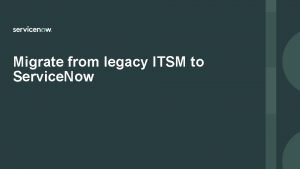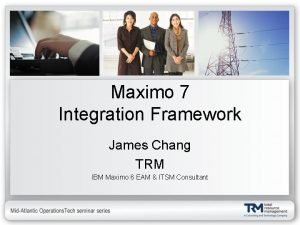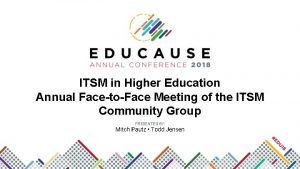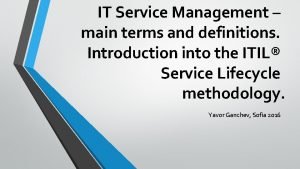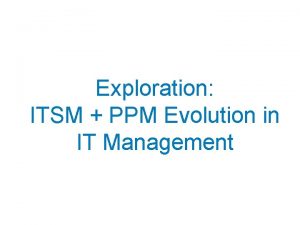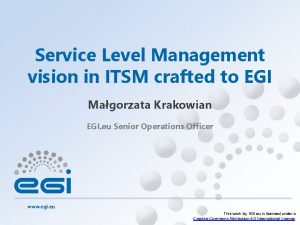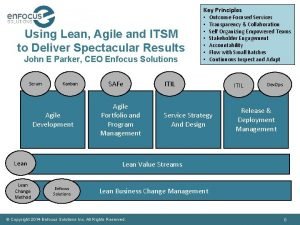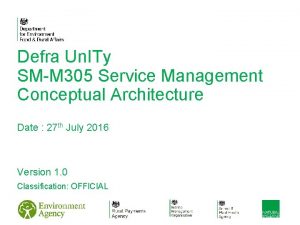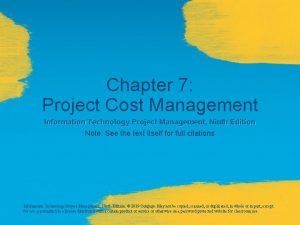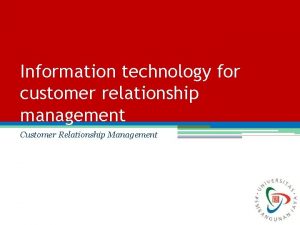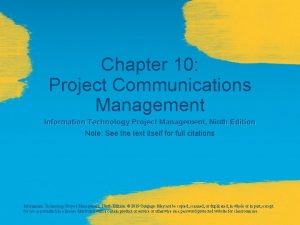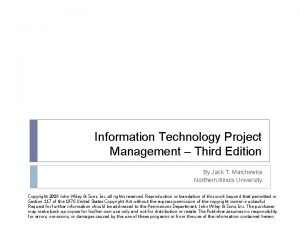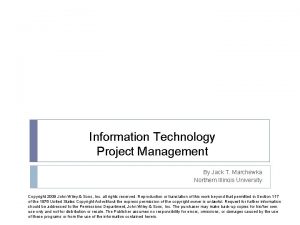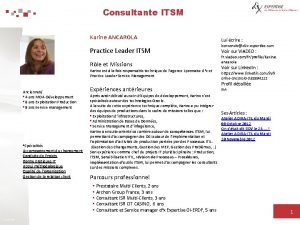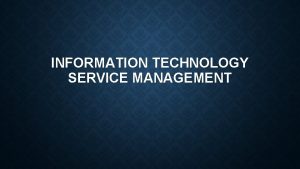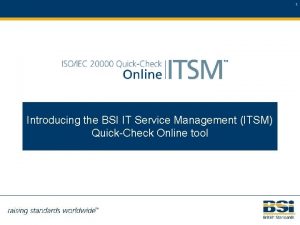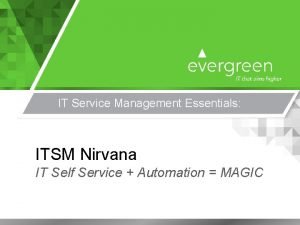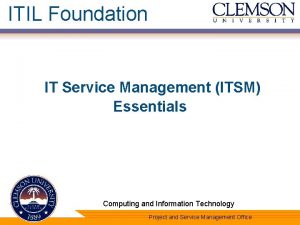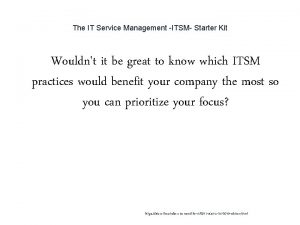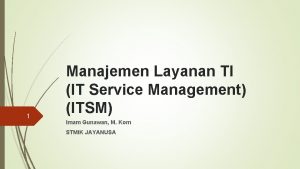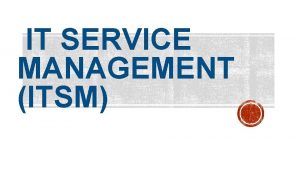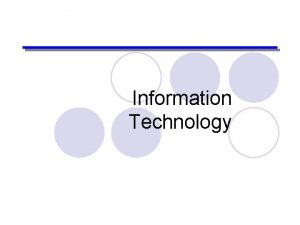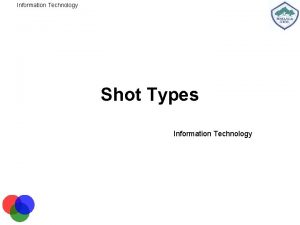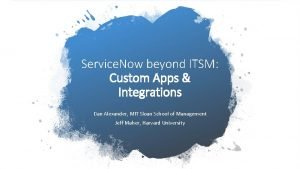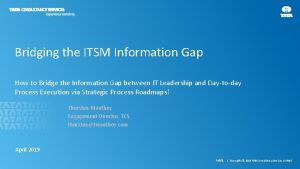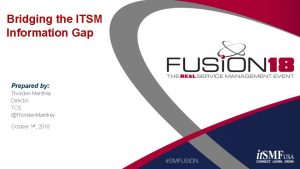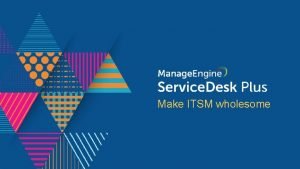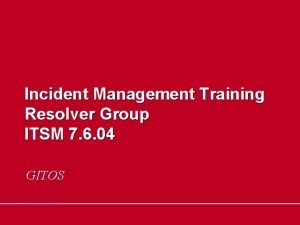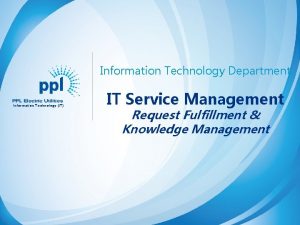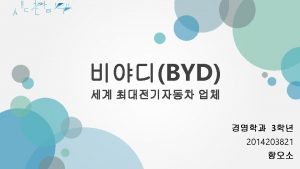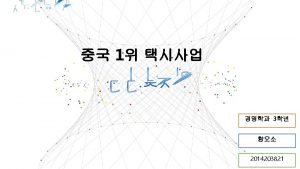Information Technology Service Management ITSM Part One of


































- Slides: 34

Information Technology Service Management (ITSM) Part One of a Four Part Series Change Management What is it? Why do I need it? How do I get it? Part 2: ITSM Overview/Service Catalog: January 23, 2019 (Southbridge, MA) Part 3: User Experience, February 28, 2019 (UMass-Amherst) Part 4: Incident Management, June 11, 2019 (Waltham, MA)

Agenda 9: 05 Introductions 9: 15 Our Change Management Stories 10: 00 Break 10: 10 Interactive activities on Change Type, Criticality, Risk 11: 40 Prep for Post Lunch CAB presentation 12: 00 - 1: 00 Lunch 1: 25 First table presents RFC to CAB 2: 15 Q&A Panel Discussion 3: 00 Close

Your presenters today… Mark Taricco Mark serves as the Director of Systems Operations in the Information Technology (IT) department at Worcester Polytechnic Institute (WPI). Kevin Wheeler Kevin is the IT Service Delivery Manager at Worcester Polytechnic Institute (WPI) Rori Boyce. Werner Rori is currently the Information Security Compliance Program Manager for the University of New Hampshire Matt Wollman Marshall White Matt currently works at Northeastern University as Sr. ITSM Analyst Marshall is a Senior Academic Technology Manager overseeing the Classroom and Customer Services and Support area of UNH.

What’s Change Management? “Change Management: The process responsible for coordinating the lifecycle of all changes. The process is triggered by a Request For Change (RFC) or change proposal. The primary objective of change management is to enable beneficial changes to be made with minimum disruption to IT services, that is, they are registered, evaluated, prioritized, planned, tested, implemented, and documented. ” “Organizational Change Management: An approach for managing the effect of change on people, which could be because of new business processes, changes in organizational structure, or cultural changes within an enterprise. Simply put, OCM addresses the people side of change management. ”

Change Management in Practice Purpose Benefits • Respond to changing business requirements • Evaluates the risk involved • Reduces Incidents • Accurately determines the cost and benefit associated with change • Creates a record for better planning of future changes • Proactive approach rather than reactive • Minimize fires and the impact to business and other team (IT) members • • Minimize Re-work. • Baseline for simplifying Change going forward • Reduces the need to evaluate the system being changed each time prior to a change • Standardize methods and procedures for change • • Reinforce organizational goals Cost Savings - Brings to light redundancies • Hardware • Applications Shift from a reactive environment towards a proactive one • Reduced support costs because of fewer incidents and faster resolution of problems

WPI Change Management Evolution

WPI Overview Approx 4, 300 Undergrad Approx 2, 000 Graduate/PHD Approx 1, 500 Faculty and Staff 80+ IT Staff

Catalyst for Change Where we Started CAB Phase 2 – Cherwell Incorporate non-IT departments

UNH Change is inevitable; it is how you manage it that matters.

UNH Overview Approx 13, 000 + Undergrad Approx 2, 400 Graduate/PHD Approx 3, 100 Faculty and Staff 180+ IT Staff

Catalysts for Change Our Journey Critical Success Factors Lessons Learned

Northeastern Change Management Evolution

NU Overview 22, 446 Undergrad 16, 730 Graduate/PHD 5, 928 Faculty and Staff ~190 IT Staff 8 Satellite campuses Network 4700 Wireless Aps >300 closets >1000 switches/router 165, 000 unique devices

NU Overview Change Management for ~10 years Forms Remedy Service. Now Everything went through CM Multiple CAB(s) Process Improving structure, moving back to center Process redesign and tool improvement

Break

But…Not all Changes are Created Equal

Game Time: Which Change Part 1 Each Table has five Minutes to take 7 scenarios and put them in order from most important to least important from a change perspective

Change Types Normal Standard Emergency Requires approval by Supervisor/ Manager, Change Manager, CAB and/or IT Leadership Approved, repeatable normal change In response to (pending) outage or to address regulations or security threat* Low to medium risk Approved either verbally or by email/ text Categorized into high, medium or low risk using the questionnaire Test script & back-out plans are required Test script & back-out plans are captured Recorded within 24 hours (1 business day) after emergency is contained Recommended test script & backout plans be filed * Security threat Emergency Changes must be communicated immediately to Info Sec for approval

Game Time: Which Change Part 2 Categorize the Changes given Discuss

Services are not all created equal! What is Service Criticality? How do we determine it? Why is it important?

Game Time: Service Criticality Each table takes their table’s service and categorizes it in terms of it’s criticality.

Risk Assessment- How risky is this change? Impact of the Change Number of Users Impacted Impact of Not Doing the Change Urgency The timeframe for completing this changes is _______ Not making the change on the date requested ____ The change must be completed during a designated blackout period Experience Have we done something like this before in production? Do we have vendor assistance? Complexity How many resources are required to implement the change? Is the procedure to implement the change simple or complex? How many services or systems are involved in the change? Testability What kind of environment is available to test the change? Do you have a test plan that will be executed prior to the change being made in production? Can you validate the change was successful immediately following implementation? Back-out Can the change be backed-out? How difficult will it be to back the change out? Is there a back-out plan?

Game Time: Risky or Not Each table uses scenarios with changes in the scenarios and determines the risk of the change

Review: Putting it all together Do you classify your changes appropriately? Did they change? Any surprises? Managing IT change is about managing risk, to be effective, you need to handle changes differently based on their risk Risk is determined by On the criticality of the service affected On the Riskiness of the change The Urgency of the change

Scheduling Change


Presenting to CAB Each table will have a spokesperson that will stand up and discuss their RFC. CAB members can ask questions. First Table at 1: 25 Wrap up by 2: 15

Lunch Break 12: 15 – 1: 15

Presenting to CAB Each table will have a spokesperson that will stand up and discuss their RFC. CAB members can ask questions. First Table at 1: 25 Wrap up by 2: 15

Presenting to CAB A typical CAB agenda A review of all failed or backed out changes A list of RFCs to be assessed by CAB members A review of all implemented changes Could also contain Change mgmt process review or enhancements Change mgmt. successes Problem management / Root Cause Analysis

Inter-related ITIL Processes Inter-related

Questions? Panel Discussion with Mark, Kevin, Rori, Matt Moderated by Marshall 2: 15 or 2: 30 – 3: 00 PM

Additional Resources Organizational Change Management John P. Kotter – Leading Change Wilkinson, Paul – ABC of ICT Rudd, Colin - ITIL V 3 Planning to Implement Service Management IT Service Management Resources Educause IT Service Management Constituent Group (CG) IT Service Management Forum Higher Ed Community of Interest (Co. I)

And even more resources! PRESS
 Itsm migration
Itsm migration Maximo integration framework
Maximo integration framework Higher ed itsm
Higher ed itsm Itsm terms and terminologies
Itsm terms and terminologies Itsm and ppm
Itsm and ppm Itsm mission statement
Itsm mission statement Lean itsm
Lean itsm Smm service suppliert
Smm service suppliert Information technology project management 9th edition
Information technology project management 9th edition Definitive estimate range
Definitive estimate range Blue project chapter 5
Blue project chapter 5 Global information technology management
Global information technology management Managing information technology resources
Managing information technology resources Information technology project management 8th edition
Information technology project management 8th edition Information technology project management 9th edition
Information technology project management 9th edition Information technology and customer relationship management
Information technology and customer relationship management Information technology project management 9th edition
Information technology project management 9th edition Information technology project management
Information technology project management Information technology project management
Information technology project management One god one empire one religion
One god one empire one religion Little dog run
Little dog run One king one law one faith
One king one law one faith Byzantine definition
Byzantine definition One ford
One ford See one do one teach one
See one do one teach one See one, do one, teach one
See one, do one, teach one Willow cabin speech
Willow cabin speech Studiendekanat uni bonn
Studiendekanat uni bonn Asean tourism strategic plan
Asean tourism strategic plan Asean one vision one identity one community
Asean one vision one identity one community Part whole model subtraction
Part whole model subtraction Unit ratio definition
Unit ratio definition Brainpop ratios
Brainpop ratios Technical description meaning
Technical description meaning Parts of a bar club
Parts of a bar club
